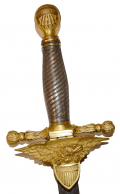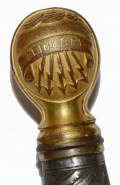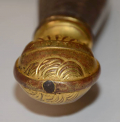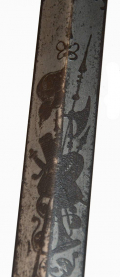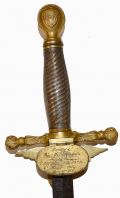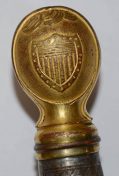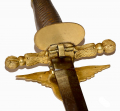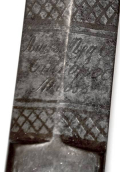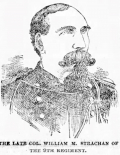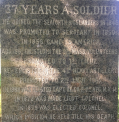site search
online catalog
BEAUTIFUL, SCARCE AMES REVENUE MARINE SWORD PRESENTATION TO A HEAVY ARTILLERY COMPANY FIRST SERGEANT BY HIS OFFICERS: THIRTY-SEVEN YEARS A SOLDIER!

$4,500.00 SOLD
Quantity Available: None
Item Code: 1052-539
The 1834 US Revenue Marine Officer’s Sword is a beautiful sword to begin with, tough to find, and this one is additionally rare in bearing a presentation on the reverse counterguard, and a rather unusual one to boot. The sword was given to a First Sergeant by his company commanding officers; they are in a heavy artillery unit, not the Revenue Marine; and, the sergeant had both prior service in the British Army and an interesting record in a Massachusetts infantry regiment, along with later postwar service as Colonel commanding a National Guard regiment, all of which led to his, likely self-composed, epitaph: “37 YEARS A SOLDIER” when he died in 1892 from the effects of a carriage accident.
Date of the pattern is derived from the Ames Sword Company catalog of 1882/83, which lists design as number 538 and describes it as the “Old Regulation Revenue and Marine,” by which they mean the old regulation “Revenue-Marine,” the earliest designation of the Coast Guard, established as an armed customs service in 1790- several years before the establishment of the U.S. Navy. The “old regulation” sword thus predates not only the one in service at the time of the catalog, a sword adopted about 1870, but also the regulation M1852 US Navy officer sword used by the service for several years starting in 1862, and is thus likely the pattern adopted, but only vaguely described, under the service’s 1834 and 1843 regulations. This one bears an etched company address on the reverse ricasso: “Ames Mfg. Co. / Chicopee / Mass” dating it to 1848 or later.
The globe pommel is topped by swirling clouds on either side of a vertical band running across the top and down the sides. The reverse bears a US shield bordered by twenty punch-dot stars; the obverse has a scroll reading “LIBERTY” and with five jagged arrowhead lightning/thunder bolts darting down from it in a strikingly modern, electrical image. The silver grip is impressed to imitate spiral bands of alternate tape and twisted wire, and is elegantly framed by the gilt brass pommel and deeply cast and chased crossguard with an acanthus leaf and flowering bulb design. Below this are two folding counterguards, the reverse a plain oval and the obverse a very deeply case and chased, detailed eagle appearing to crouch underneath the crossguard quillons, perched on top of a U.S. shield. The brass shows as a medium brass with noticeable gilt remnants. The silver grip is unpolished, with a natural, muted patina, and retains its detailing.
The blade is a flattened diamond shape in cross-section with a short ricasso, double-edged, and with a spearpoint tip. The edges and point are good. The blade has smooth metal with some scattered dark spots. Both sides are etched on a long panels with Arabesque spearpoint terminals with the motifs fully legible against the frosting, which shows silvery mixed with some dark spots. The obverse is etched with floral scrolls and lattice-work geometric and structural motifs leading up to a trophy of arms with trumpet, sword, shield, lance, halberd with tall central spike, etc., followed looser floral scrolls, a vertical fouled anchor with eagle atop it, and ending with more floral scrolls. The reverse is etched with the firm name at bottom followed by a leafy branch with acorns (usually associated with the US Navy,) a large fouled anchor, followed by floral scrolls and similar latticework designs, with two floral-entwined sets of arms, the upper one including a trident, evoking Neptune and appropriate to a naval sword.
The reverse folding counterguard is professionally engraved, “Presented to Wm. M Strachan / by the / Officers of the 26th Co. / Heavy Artillery / Sept. 12th 1864.” Use of a Revenue Marine sword is not entirely inappropriate since the Independent Companies of Massachusetts Heavy Artillery were initially used as garrisons for forts in Boston Harbor, making both services relevant to coastal defense. This particular company ended up as part the 4th Mass. Heavy Artillery near Washington, but was organized on Gallop’s Island in Boston Harbor. It certainly made an elegant non-regulation alternative to a M1840 NCO or M1833 Heavy Artillery short sword, for although Strachan gained a commission a few months later, at the time was only a company First Sergeant, making the presentation and the quality of the gift an unusual sign of respect from his commanding officers. Strachan’s military experience, however, would seem to have merited it. Born in Scotland in 1838, he had enlisted in the British army 1846 and reaching the rank of Sergeant in the Seaforth Highlanders (likely meaning the 72nd or 78th regiments before their amalgamation) in 1850. He emigrated to the U.S. 1856, apparently after ten years of service, according to his epitaph and on April 15, 1861, enrolled in the Massachusetts militia, serving in what became the 9th Massachusetts Volunteer Infantry after mustering into U.S. service on June 11, 1861, when he was made regimental Sergeant-Major, in all likelihood on the basis of his British military experience.
Strachan’s bearing and assumption of authority seems to have alienated some of the volunteers, particularly the writer of the regimental history who, as a First Sergeant, chafed under his command and performed something of a damnatio memoriae in largely eliminating him from the unit’s history, mentioning him just twice, not by name, and in less than flattering terms. First, on the regiment’s voyage by ship to Washington: “The First Sergeant’s Call” was quite a familiar one during the voyage, so much so that the sergeant-major had a drummer at his elbow at all times for the sole purpose of issuing and repeating many very trivial orders. All the business of the companies seemed to have shifted from the commissioned officers onto the shoulders of the 1st sergeants. The sergeant-major appeared to have assumed, in a measure, control of the colonel’s and adjutant’s prerogatives; an assumption that he wielded with all the serio-comic dignity of a martinet, such as can only be found in a foreign army.” We emphasize that last line.
The second time refers to the establishment of their new camp on Arlington Heights on June 24:
“That afternoon is memorable in the minds to the 1st sergeants of the regiment on account of the great amount of “double-quick” duty performed by them in answer to the numerous “calls” of the sergeant-major… about every fifteen minutes or so..” and attributed it to his desire to “impress the colonel and others with his untiring activity at headquarters or show his subordinate non-commissioned officers his authority over them…” The regiment remained in that camp until late September and whatever others thought, Strachan did impress his superiors enough to be appointed 1st Lieutenant and Adjutant on August 5, 1861.
Strachan’s career, however, was derailed at the beginning of 1862 when he was charged with desertion. We do not the circumstances and the charges could have resulted from little more than an overstayed leave of absence, but the above citations indicate he may have had little support in the regiment and the upshot is that he was dismissed from the service on Feb. 25, 1862. Despite this humiliation or because of it, he determined to clear his reputation as a soldier and enlisted again not only volunteering as a private, but doing so his old outfit, the 9th Massachusetts, on August 18, 1862. Remarkably, his abilities again were recognized and he again moved up in the ranks, being promoted to his old rank and post as Sergeant Major on Sept. 26, 1862. During his absence the regiment had suffered heavily in the Peninsula Campaign and was held in reserve at Antietam and Fredericksburg, while he was back with it, but he seems to have redeemed himself at least in the eyes of Major Dutton, who noted on his discharge for disability on Feb. 14, 1863: “He has been a good soldier but is now rendered totally unfit for further military service on account of his lameness.”
Strachan’s devotion to military duty came to the fore twice more. The first occasioned the presentation of this sword. He enlisted Aug. 15, 1864, on Gallop’s Island in the 26th Independent Company Mass. Heavy Artillery and was mustered in as First Sergeant on Aug. 18. He likely impressed his superiors and helped mold the company as he had done in 1861, though perhaps with less friction. The presentation of the sword on September 12 corresponds with the period when the 17th through 28th Independent Companies were left the state in three detachments for Washington, where they were posted to the defenses of Washington and organized as the 4th Massachusetts Heavy Artillery in November. Strachan’s company became Company K of the regiment and in February Strachan once again became officer, mustering in for duty as a 2nd Lieutenant on Feb. 27 and joining Company F on March 1. In that capacity he mustered out with the regiment on June 17, 1865.
Strachan’s story would not be complete without mention of his postwar service in the Massachusetts national guard, being elected a Captain in 1869, a Lieutenant Colonel in 1872, and Colonel in 1879, a rank he held until his death in 1892. It must have given him some satisfaction, however ironic, that the militia regiment of which he ended up Colonel was the 9th Massachusetts.
His epitaph reads: “37 YEARS A SOLDIER / HE JOINED THE SEAFORTH HIGHLANDERS IN 1846/ IN 1856 CAME TO AMERICA / IN 1861 ENLISTED IN THE 9TH MASS VOLUNTEERS / PROMOTED TO 1ST LIEUT / RE-ENLISTED IN THE 4TH HEAVY ARTILLERY / PROMOTED TO 2ND LIEUT. 1865/ IN 1869 WAS ELECTED CPAT. OF CO. F 9TH REG. MV.M. / IN 1872 WAS MADE LIEUT. COLONEL / IN 1879 WAS ELECTED COLONEL / WHICH POSITION HE HELD UNTIL HIS DEATH.” [sr] [ph:L]
~~~~~~~~~~~~~~~~~~~~~~~~~~~~~~~~~~~
THIS ITEM, AS WITH ALL OTHER ITEMS AVAILABLE ON OUR WEB SITE,
MAY BE PURCHASED THROUGH OUR LAYAWAY PROGRAM.
CLICK HERE FOR OUR POLICIES AND TERMS.
THANK YOU!
Inquire About BEAUTIFUL, SCARCE AMES REVENUE MARINE SWORD PRESENTATION TO A HEAVY ARTILLERY COMPANY FIRST SERGEANT BY HIS OFFICERS: THIRTY-SEVEN YEARS A SOLDIER!
For inquiries, please email us at [email protected]
Most Popular
Historical Firearms Stolen From The National Civil War Museum In Harrisburg, Pa »
Theft From Gravesite Of Gen. John Reynolds »
Selection Of Unframed Prints By Don Troiani »
Fine Condition Brass Infantry Bugle Insignia »
British Imported, Confederate Used Bayonet »
Scarce New Model 1865 Sharps Still In Percussion Near Factory New »
featured item
SUPERB, RARE MOUNTED SERVICE GREATCOAT
This style of cold weather coat is among those which replaced the long-standing model 1819/32 overcoat in favor of the US model 1851 style, the primary overcoat utilized by US army during civil war. While retaining previous patterns sky blue cloth it… (490-7134). Learn More »
site search
Upcoming Events
May 16 - 18: N-SSA Spring Nationals, Fort Shenandoah, Winchester, VA Learn More »




